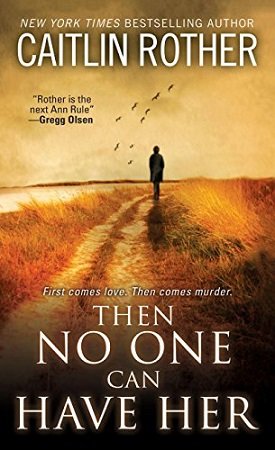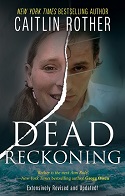 I am thrilled to welcome best-selling true crime author Caitlin Rother back to Colloquium today. Her tenth book, Then No One Can Have Her, has just been published and is earning high praise from both reviewers and readers, including me.
I am thrilled to welcome best-selling true crime author Caitlin Rother back to Colloquium today. Her tenth book, Then No One Can Have Her, has just been published and is earning high praise from both reviewers and readers, including me.
It is the true story of the murder of Carol Kennedy, a mother of two girls, who had finally become empowered enough to extricate herself from her codependent, dysfunctional marriage to Steven DeMocker, a charming, manipulative womanizer. Even though the divorce left her drowning in debt, Carol was establishing a new life on her own terms.
Savagely murdered in her own home outside Prescott, Arizona, the killer attempted to make the crime scene appear as though Carol had fallen and sustained fatal injuries. Despite numerous flaws in the homicide investigation and years of unfathomable legal complications, DeMocker was finally convicted and is serving a life sentence plus twenty-one years.
The Back Story: Behind the Writing of Then No One Can Have Her
With all its legal twists and turns, Then No One Can Have Her, the story behind the Steven DeMocker murder case, is one of the most complex I’ve ever encountered as an author. This is my tenth book — a personal milestone for me — and yet, even with all that experience under my belt, I still felt like this story was a bear I had to wrestle to the ground.
But this case really got to me on a personal level as well. Not only were the facts of it tough at times, but it also brought up some ghosts from my own past. As a result, the journey of researching and writing this story alternated between being emotionally gut-wrenching and intellectually challenging.
At the outset, I wondered how someone could murder such a peaceful, loving and spiritual being like Carol Kennedy and in such a horribly violent way. I wondered how and why, as someone who had counseled battered women and women in recovery, she stayed with her “soul mate” Steve for so long. I could almost feel what she described as her “self-torture,” the pain of loving someone who had hurt and manipulated her for so many years, and I felt bad for her when her younger daughter, Charlotte, sided with Steve in the divorce battle.
By the same token, I was also amazed at how Steve could keep so many women on the line, even his own family members, thinking he was such a good sensitive guy, and yet treat Carol the way he did. I wondered how he could spend and borrow so much money and cheat with so many women, and yet not be willing or able to rein himself in. Was it compulsiveness, narcissism, entitlement, greed or addiction?
I tried not to judge, I just dug in and searched for the answers to these psychological questions so I could illustrate and explain the dynamics of Steve and Carol’s very textured and complicated lives. Along the way, I felt I got to know Carol Kennedy better than most murder victims I’ve written about, and I wanted to pay her and her story the utmost respect.
When I learned that Carol had once told a reporter that she wanted to write a book about domestic violence some day, I felt I had her blessing. When her close friend Katherine told me about a dream in which she described me to Carol, who then said, “she sounds wonderful,” I felt happy, as if I were really on the right track. And then, when I watched a video of Carol talking, it almost felt like she was speaking to me from wherever her spirit had gone.
I was also drawn in by the crisp beauty and dark corners of Prescott, a small town that still seems to hold on to remnants of the Wild West and allowed Steve to womanize without consequences for so long. I was intrigued by the messiness of this ever-evolving criminal investigation, some of the scattershot methods used and also the detectives’ dedication to pin down leads in the end. The endless court filings and legal hyperbole. The kooky medical examiner who transported Carol’s body in his truck and sent investigators on such a wild goose chase to find the source of the mysterious male DNA under Carol’s fingernails, dubbed “Mr. 603.” The ethical allegations flying in every direction, the anonymous email, the voice in the vent, the insurance money transfers. The judge with the brain tumor and the judge from the “sweat lodge” case, the Docugate scandal, and the bombshell email that got thrown out on this roller coaster ride to justice. Suffice it to say that I came to empathize with the attorneys in this case, because there was so much information it became a challenge to decide what to include and what to leave out.
One of the unusual aspects of telling this story was that I had to rely more than I typically do on document research and court transcripts and less on my own interviews with human beings. That’s because no one from the sheriff’s office or the county attorney’s office would agree to talk to me, citing “legal and ethical rules” and the pending appeal. That said, the prosecution was very cooperative with releasing public records, many trial exhibits, crime scene photos; thousands of pages of investigative reports and witness interviews; and audio files and transcripts of Steve’s many recorded jailhouse calls. I also had access to five years of court filings and transcripts from both trials online.
I tried to interview Steve’s daughters, but my attempts to do so went unanswered or rebuffed, so I respected the girls’ obvious wish to be left alone. I tried to tell their side of the story through their own words when I could, or through those close to Carol who knew them well.
My repeated efforts to speak with Steve DeMocker, his parents, siblings and defense team were all rebuffed as well. Defense investigator Rich Robertson told me that because Steve’s family believes he was wrongly convicted, they saw no reason to talk to me for this book. That said, I think Steve’s and his family’s comments at the sentencing, as well as the emotions they expressed in the jail calls after the verdict, are indicative of what they likely would have said to me. Luckily, I found others who were more than willing to talk about him and what makes him tick.
Although I’m not required to give a balanced version of the case in a book as news outlets are supposed to, I also don’t like to write one-sided stories quoting only those people who think the convicted killer was a bad person and did the deed. I’m grateful that Robertson made himself available to me so there was least one human being representing Steve’s and the defense’s perspective. I just wanted to state for the record that it wasn’t for lack of trying on my part.
I don’t believe that anyone — even a convicted killer — is all bad, any more than I think crime victims or their family members are all good. People are flawed. In this case, Carol and Steve were victims of love, obsession and addiction as well as a desire to make their relationship work and last, despite numerous red flags along the way telling them to stop. This is a tragedy all around, especially for their daughters, who have now effectively lost both parents.
It felt very rewarding to get such an extraordinary degree of cooperation from Carol’s family and close friends. Like me, they wanted Carol and her spirit to be remembered in a case that has been so centered on Steve. I know that rehashing some of this was very difficult for them, and I am thankful that they helped me capture her and her words. I also am grateful for the contributions of Sturgis Robinson, who gave me some crucial insights into Steve’s character.
I don’t want to give too many details away, but hopefully I have intrigued you enough to pick up a copy of the book and read it!
Meet Caitlin

Caitlin Rother was an only child who entertained herself “by reading stacks upon stacks of books and using my mind as a stage where characters talked to each other.” She holds a Bachelor’s degree in psychology from the University of California, Berkeley and earned her master’s degree from the Medill School of Journalism at Northwestern University. In high school and college, she explored journalism, but opted for a career in public relations with a San Francisco cruise line. Eventually, though, she was compelled to choose the “balance and objectivity of newspapers over the positive spin world of PR, marketing and advertising, . . . ”
It was not until the late 1980s that she joined a writing workshop in Northampton, Massachusetts, in her quest to write more in-depth, creative stories while toiling as a reporter with the Springfield Union-News. The series of short stories produced in that workshop eventually evolved into her first novel, Naked Addiction.
As an investigative journalist, Caitlin was drawn to “complex and dramatic stories – the most bizarre or tragic deaths and the public figures whose questionable actions evoked my investigative curiosity.” She wrote about Michael Jackson’s original molestation charges and addiction to painkillers, the lifestyle of the Heaven’s Gate cult and strippers’ laundered political contributions to San Diego City Council members, and developed expertise in addiction (alcohol and methamphetamine, suicide, mental illness and the family dynamics and pharmacology involved).
She expanded a series of news stories about the Kristin Rossum murder case into what would become her first book, Poisoned Love. In 2006, she contracted to draft her second non-fiction book and in a risky leap of faith, left the security of her position with The San Diego Union-Tribune behind.
In 1998, Caitlin was nominated for a Pulitzer Prize by the Union-Tribune. Her story about a depressed teenager who died after lighting himself on fire behind a WalMart won three awards in the annual Best of the West contest. Her journalistic honors also include a Best Feature award from the Associated Press News Executives Council and Best News-Feature award from the Los Angeles Press Club.
Caitlin is a sought-after speaker who also helps aspiring authors as a book doctor and writing/research/promotions coach and consultant. She teaches narrative non-fiction, digital journalism, and author branding/promotions at the University of California, San Diego Extension and San Diego Writers, Ink.
Her other books include Deadly Devotion/Where Hope Begins; My Life, Deleted; Body Parts; Twisted Triangle; and I’ll Take Care of You, the story behind the love triangle murder of Newport Beach multimillionaire inventor Bill McLaughlin by his fiancee, Nanette Packard, and her NFL-playing lover, Eric Naposki.
Connect with Caitlin via her website, or on Facebook or Twitter.















Comments are closed.